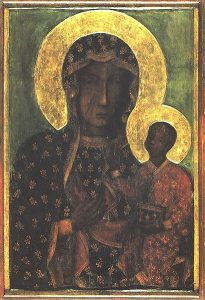
GOOD MORNING POU!
We continue our look at The Black Madonna and Child…
Black Madonna of Częstochowa
Częstochowa, Poland
From Wikipedia:
The Black Madonna of Częstochowa (Polish: Czarna Madonna or Matka Boska Częstochowska, Latin: Imago thaumaturga Beatae Virginis Mariae Immaculatae Conceptae, in Claro Monte) is a revered icon of the Virgin Mary housed at the Jasna Góra Monastery in Częstochowa, Poland.
The icon
The origins of the icon and the date of its composition are still hotly contested among scholars. The difficulty in dating the icon stems from the fact that the original image was painted over, after being badly damaged by Hussite raiders in 1430. Medieval restorers unfamiliar with the encaustic method found that the paints they applied to the damaged areas “simply sloughed off the image” according to the medieval chronicler Risinius, and their solution was to erase the original image and to repaint it on the original panel, which was believed to be holy because of its legendary origin as a table top from the home of the Holy Family. The painting displays a traditional composition well known in the icons of Eastern Orthodoxy. The Virgin Mary is shown as the “Hodegetria” (“One Who Shows the Way”). In it the Virgin directs attention away from herself, gesturing with her right hand toward Jesus as the source of salvation. In turn, the child extends his right hand toward the viewer in blessing while holding a book of gospels in his left hand. The icon shows the Madonna in fleur de lys robes.
History
Lucan tradition
The icon of Our Lady of Częstochowa has been intimately associated with Poland for the past six hundred years. Its history prior to its arrival in Poland is shrouded in numerous legends which trace the icon’s origin to St. Luke who painted it on a cedar table top from the house of the Holy Family.[1][2]
Arrival in Częstochowa
One of the oldest documents from Jasna Góra states that the picture travelled from Jerusalem, via Constantinople and Belz,[2] to finally reach Częstochowa in August 1382 by Władysław Opolczyk, Duke of Opole.[citation needed] However more recent Ukrainian sources state that it was taken by Władysław Opolski from the Castle of Belz, when the town was incorporated into the Polish kingdom and that earlier in its history it was brought to Belz with much ceremony and honors by Knyaz Lev I of Galicia.[3] The golden fleur-de-lis painted on the Virgin’s blue veil parallel the azure, semee de lis, or of the French royal coat of arms and the most likely explanation for their presence is that icon had been present in Hungary during the reign of either Charles I of Hungary and/or Louis the Great, the Hungarian kings of the Anjou dynasty, who probably had the fleur-de-lis of their family’s coat of arms painted on the icon. This would suggest that the icon was probably originally brought to Jasna Gora by the Pauline monks from their founding monastery in Hungary.
Coronation as Queen and Protectress of Poland
The Black Madonna is credited with miraculously saving the monastery of Jasna Góra (English: Bright Mount) from a 17th century Swedish invasion,[2] The Deluge.
The Siege of Jasna Góra took place in the winter of 1655 during the Second Northern War / The Deluge — as the Swedish invasion of the Polish-Lithuanian Commonwealth is known. The Swedes were attempting to capture the Jasna Góra monastery in Częstochowa. Their month-long siege however, was ineffective, as a small force consisting of monks from the Jasna Gora monastery led by their Prior and supported by local volunteers, mostly from the szlachta (Polish nobility), fought off the numerically superior Germans mercenaries, saved their sacred icon, the Black Madonna of Częstochowa and, according to some accounts, turned the course of the war.
This event led King John II Casimir Vasa to “crown” Our Lady of Częstochowa (“the Black Madonna”) as Queen and Protector of Poland in the cathedral of Lwów on April 1, 1656.
Legends about the Madonna’s appearance
Another legend concerning the Black Madonna of Częstochowa is that the presence of the holy painting saved its church from being destroyed in a fire, but not before the flames darkened the fleshtone pigments.
The legend concerning the two scars on the Black Madonna’s right cheek is that the Hussites stormed the Pauline monastery in 1430, plundering the sanctuary. Among the items stolen was the icon. After putting it in their wagon, the Hussites tried to get away but their horses refused to move. They threw the portrait down to the ground and one of the plunderers drew his sword upon the image and inflicted two deep strikes. When the robber tried to inflict a third strike, he fell to the ground and squirmed in agony until his death. Despite past attempts to repair these scars, they [who? when?] had difficulty in covering up those slashes (as they found out that the painting was painted with tempera infused with diluted wax). In commemoration of the attack, two slashes on her right cheek were made by a pen. [when? by whom?] [1]
Another legend states that, as the robber struck the painting twice, the face of the Virgin Mary started to bleed; in a panic, the scared Hussites retreated and left the painting.
Present day
Because of the Black Madonna, Częstochowa is regarded as the most popular shrine in Poland, with many Polish Catholics making a pilgrimage there every year. Often, people will line up on the side of the road to hand provisions to the pilgrims as those who walk the distance to Częstochowa walk the entire day and have little means to get things for themselves.

